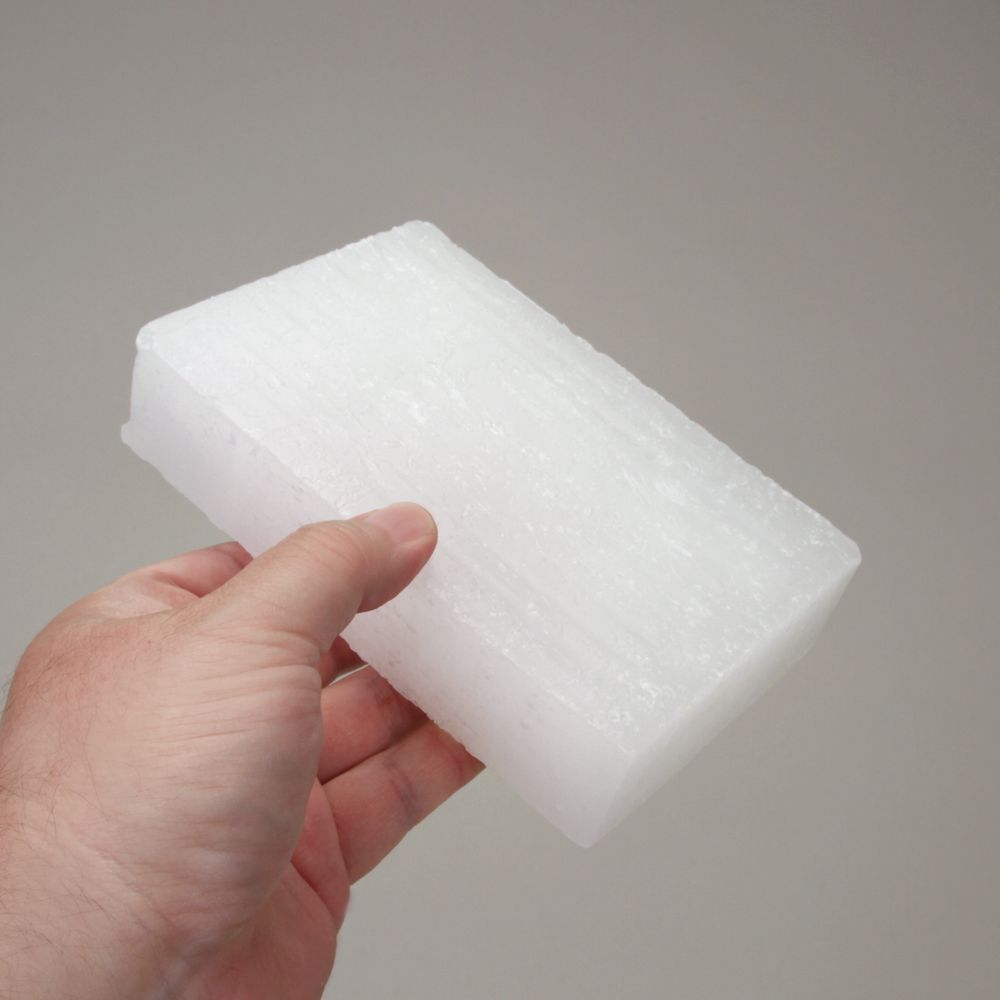refined paraffin wax

Paraffin Wax Production at the Refinery
The following process and equipment has been prescribed for the refining of block paraffin.
The slack wax from the chill room is melted and pumped to shallow steel pans in the sweater house, which houses several sweating ovens. The latter are well insulated rooms which accommodate one or two stacks of the long pans or trays. The pans are 8 by 20 feet and about 8 inches deep at the ends, but slope to a depth of 14 inches at the center, the pans are usually stacked eight high.
A rack of light angle or tee iron is laid in the pan and carefully leveled. A very coarse galvanized iron mesh is stretched across the rack; and over this is placed a brass wire gauze which is securely fastened to the rack, and which supports the cooling coil. There is a 2-inch space between the bottom of the pan and the gauze into which the cold water is pumped and circulated. The melted wax is run onto the surface where it congeals to a sheet of 4 to 6 inches thickness. After solidification the pans are tilted, the oven is lightly closed, and the water run off.
The sweater oven has steam coils along the walls and under the pans for controlling the interior air temperature, and is equipped with vertical ducts between the frames to allow for air circulation. By a thermostatic regulator the temperature is raised 1 or 2 °F per hour, and the oil and soft wax that sweats out is drained off from time to time. The first running, or light foots oil, is used as a plant fuel, but the next, or heavy foots oil fraction, is pumped back to the wax distillate, and subsequent fractions are re-sweated, or used later for blending before the acid treatment. The end product is a block wax of 130-132°F melting point, which still requires a finishing treatment to remove color.
Thereafter the wax is melted and run into agitators (lead-lined and steam-jacketed), treated with strong sulfuric acid, violently agitated for 30 minutes, and settled for one hour. The acid sludge is then drawn off and the melted wax is run into another agitator, in which it is washed with hot water and then with sodium hydroxide and finally with a hot water spray. After removing traces of water by long settling, the wax is dried finally by blowing air through it.
The melted wax at this stage is not entirely colorless, and hence is run through vertical filters of hot fuller’s earth. The filtered, bleached, refined wax is run into a slab mold, 40 feet or more in length, which consists of a tank-like structure having a sealed bottom, open top, and a large-size turnscrew at one end. In this housing is a series of compartments formed by chill plates, each plate is filled with chilled brine and connected to the other with a flexible hose so as to provide a continuous circulation. The plates are about 2 inches thick and spaced inches apart. The mold is filled with melted wax and the wax seeks its level by filling each compartment. When the wax shrinks on cooling, an extra portion of melted wax is released into the mold. After the wax is congealed, the screw at the end of the mold is unturned to loosen the plates, the plates are manually pried apart sufficiently to lift out the slabs of wax. After stripping, surplus wax is removed from the end of the slab. These slabs constitute the fully refined paraffin of commerce. They are 12” x 18” x 1H” in size, weigh about 10 pounds each, and are packed in bags or cartons stamped with the AMP melting point. The paraffin is also packed loose or on pallets and shipped in paper-lined freight cars.
Refined Paraffin Wax
A refined mixture of associated solid paraffin hydrocarbons or paraffins is commonly designated as “paraffin wax.” The word “paraffin” appears to be a French derivative of the Latin parum, meaning “little,” and affinis, meaning “affinity”; in other words, a chemically inactive substance. The high-melting grades are customarily produced free from impurities and are referred to as “fully refined paraffin waxes,” or by the simple designation or English term “paraffines”; for example, Asiatic paraffines are said to contain paraffins in the range of Cn to C3<. Reichenbach obtained paraffin wax from wood tar in 1830, and later by the distillation of lignite, as patented by James Young in 1850. In the United States paraffin wax was first obtained from petroleum in 1868. Today, paraffin wax is produced from many “crudes” that are designated “paraffin-base oils” because of their wax content.
The wax-bearing crudes of America contain on the average less than 5 per cent of merchantable wax. Those of Galicia yield less than 3 per cent, and those of Burma 8-10 per cent. Canadian crude oils yield less than 3 per cent of paraffin wax. Much of the Russian petroleum contains no paraffin wax; an exception is the so-called “mazouts” of Northwest Caucasus which are wax-bearing.
Fully Refined Paraffin Wax
The term “fully refined” is given to paraffin waxes which are water white, free from more than a mere trace of oil, odorless and tasteless, and hard or firm in consistency. The oil plus moisture content should be well within the allowable optimum of 0.5 per cent.
Fully refined paraffin wax has a friable, coarse, fibrous crystalline structure which is translucent to opaque white in appearance, particularly noticeable when a slab of the wax is broken. Microscopically its structure when crystallized from a solvent shows more or less circular or oval aggregates or platelets of cells; the fibrous characteristic in large masses appears to be due to superimposed aggregates of platelets.
Paraffines have a melting point range of 118-155°F (ASTM D-87), but ordinarily the graded melt in the range of 126-137°F, or considerably lower than microcrystalline wax. A paraffine has a color of +21 or lighter (ASTM D-156).
When melted the average grade of paraffine has a viscosity of 40-50 seconds, Saybolt at 210°F, equivalent to 4.2-7.3 centistokes, or appreciably lower than the viscosity of microcrystalline wax. Fully refined paraffin wax (m. ca. 130°F) has a specific gravity of 0.910; a flash point not less than 177°C (350°F) and usually over 400°F, and a specific heat of about 0.694 calorie per gram. Its mean refractive index (nd) is 1.5277-1.538 at 25°C, and 1.430-1.433 at 100°C. The average paraffin wax has a molecular weight of 350-420 and contains normal hydrocarbons with a mean value of C25 to C27. Waxes prepared from mixed base type crudes are said to have a small proportion of side-chain hydrocarbons (side-chain alkanes).
A specimen of Esso brand paraffin wax 128/130°F (ASTM) melted at 129.5°F, and had an oil content of 0.3 per cent, color +30 Saybolt, tensile strength 300 psi, modulus of rupture 400, and flexibility 0.001” units-50.
The demand for American paraffines of the higher melting points, 130/132,133/135, and 135/137°F AMP, has greatly increased, and the use of lower melting point paraffines has correspondingly decreased. There is only a restricted demand for paraffines melting between 143 and 150°F. These higher melting point waxes may constitute 25 per cent of the total yield of a modem refinery, and hence they are used largely to blend with paraffin waxes melting below 128°F to obtain marketable grades. A paraffine of 151°F melting point has a SITS viscosity of 43 at 210°F, a tensile strength of 151 psi at 70°F, 195 psi at 40°F, a color of 30 Saybolt, a stain pass at 135°F, and an oil content (MEK) of less than 0.5 per cent.

